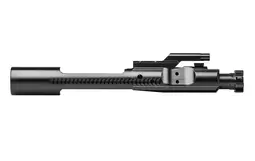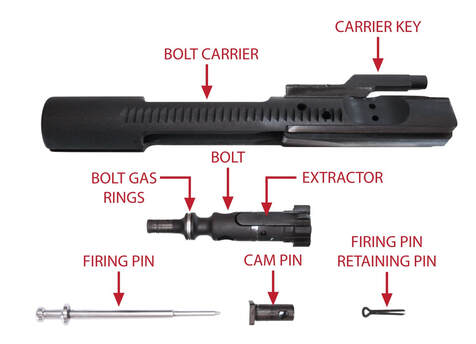How does a Bolt Carrier Group (BCG) work? A Bolt Carrier Group is responsible for performing semi-automatic fire when the trigger is pulled. This happens with this series of steps:  1) Allowing the firing pin to strike the primer on the chambered round. 2)Grabbing and ejecting the spent shell casing from the fired round. 3)Re-cocking the hammer in the lower receiver for the next round. 4)Grabbing a new round from the magazine and chambering it. The steps above happen when the shooter pulls the trigger. This act of chambering a new round and cocking the hammer allows the cycle to repeat. Thus, eliminating the need for a manual bolt or single-shot configuration. BCG preform these tasks by harnessing the gas produced by the round being fired. A gas port connects to a gas tube on the barrel to the carrier key that is attached to the BCG. The carrier key forces all the high-velocity gas into the body of the BCG. As this happens, the BCG unlocks and is driven backwards into the upper receiver. Then the simultaneous action of ejecting the spent casing and chambering a new round happens. This entire process happens in less than one second. This makes is way more efficient than a bolt-action rifle. Coating Options for a BCGManganese Phosphate (Parkerized ™ Coating): This coating is a mil-spec coating that has 50 Years of US military use. It is the most common among the types of coating. It is also the most economical in price and most durable. It has a high corrosion resistance. The drawback of this coating is the surface of the coating is more porous than other coating which makes it harder to clean. Chrome Coating: Chrome coating has the superior hardness when it comes to coating as it reduces porosity. It is smooth and easy to clean. Unfortunately, it has lost its popularity due to newer coating technologies for it can be quite expensive. Chrome can become brittle and flake off with time. Nitride Coating (Nitrocarburizing, Black nitride, Melonite™, QPQ, Tennifer™): Nitride coating is not technically a coating it is a chemical treatment resulting in a hardened black surface. This results in a durable and highly corrosion resistant surface. This makes it easier to clean than phosphate coatings. Electroless Nickel (NiB, EXO™, NP3™, Nickel Boron Nitride): This is a coating process where the result is a thing surface layer that is harder than the underlaying metal. It has excellent dry lubricating properties, and its most common finish is the nickel boron or NiB. Electroless nickel tends to enhance the hardness and/or lubricity of coating. The draw back of this coating is that it wears off in time and coating process needs to be repeated. Vapor Deposition (IonBond™, Titanium Nitride/TiN, PVD, CVD): This process results in a coating that is thin, extremely hard, and slippery which reduces the need for lubricants and speeds up cleaning. Vapor deposition is the newest of technologies in coating. It is the fastest growing category of coatings. The exciting part of this innovative technology is the color of the finish can be customized, but it can be often two to three times the price of phosphate. Of the diverse types of vapor deposition, CVD is viewed as superior to PVD as it provides a more complete coating which adheres better to the metal. Calibers that BCG come in: Requiring a Barrel Change only:
Requiring no barrel change if used with a conversion kit:
Requiring a barrel, bolt, and magazine change:
Requiring a barrel, bolt, modified upper receiver and magazine change:
At Black Bag Resources we offer a variety of Bolt Carrier Group brands. The brands we carry are Aero, White Label Armory, Odin Works, and Faxon. We also can help in determining which brand suites the caliber change needed for your desired changes or build.
0 Comments
|
Black Bag Resources Blog
News, projects, products, and tips from the owner. Archives
September 2022
Categories
All
|


 RSS Feed
RSS Feed